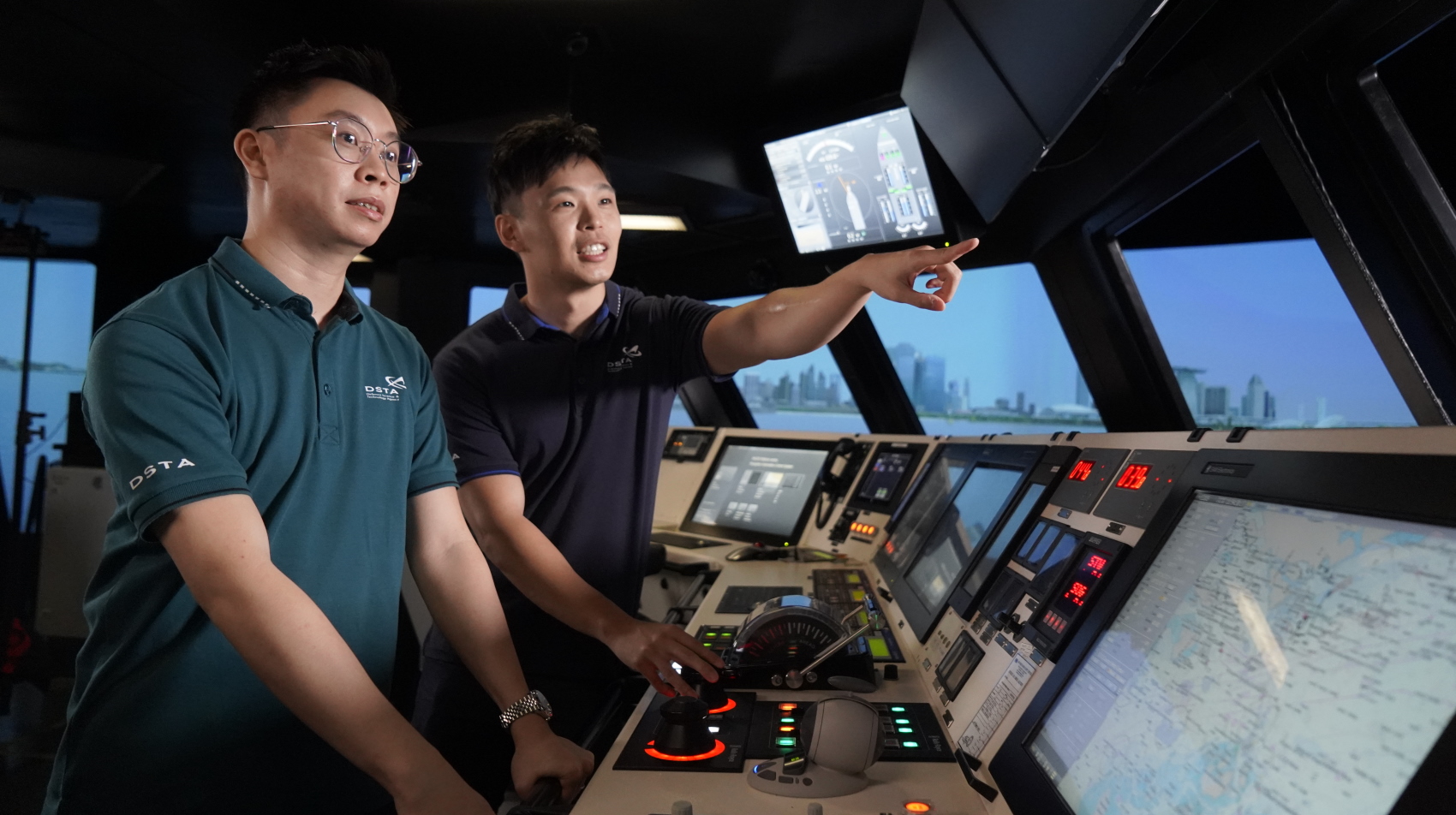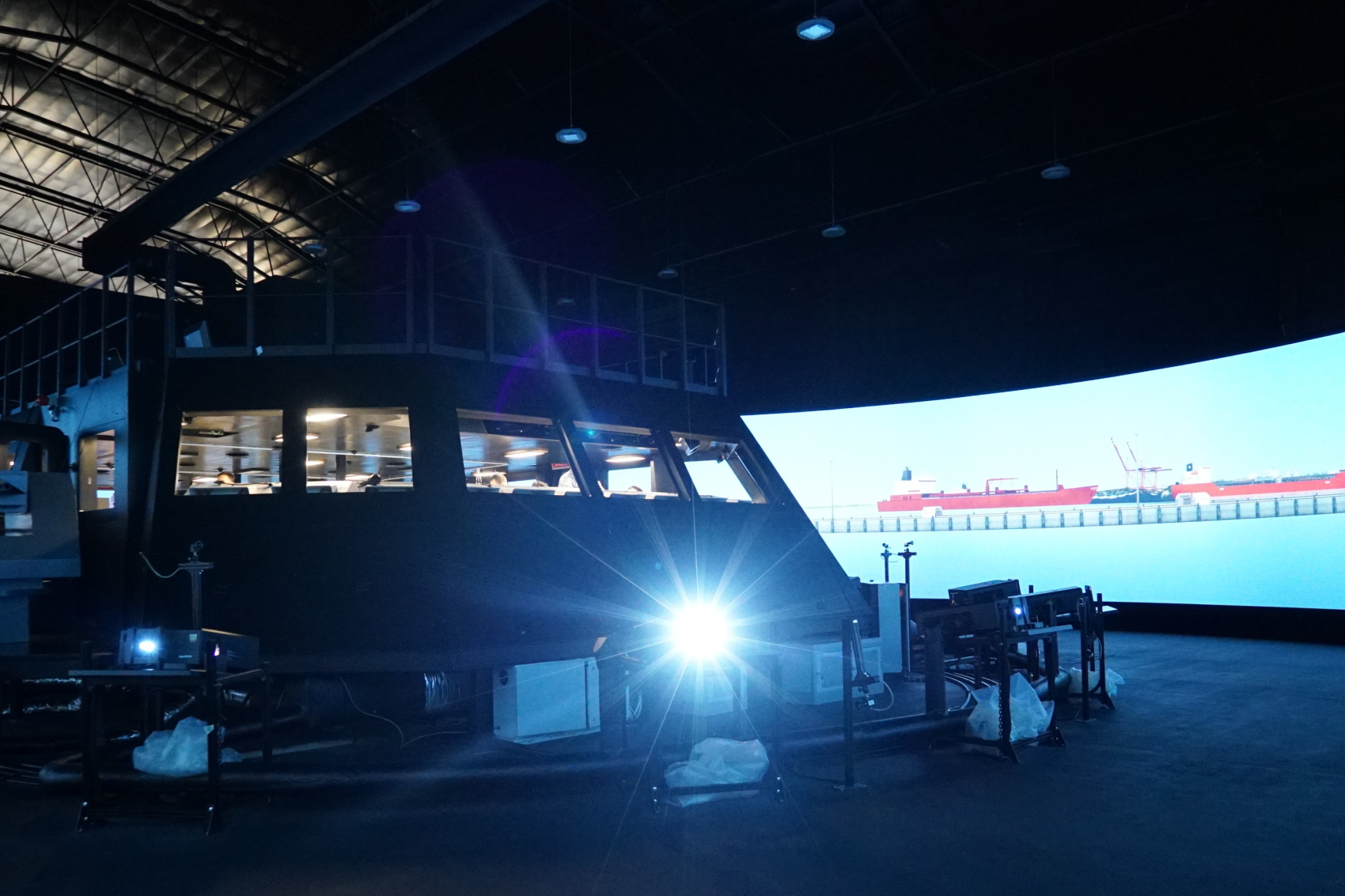29 Sep 2021
RSS Daring may sound like the name of a warship, and it even looks just like one when you step into it. But its real identity is an immersive 360-degree simulator to train RSN crew on the Littoral Mission Vessels (LMV).
Conceptualised by DSTA and the RSN, and better known as the LMV Simulation Centre (SIMCEN), it is a one-stop integrated environment for realistic training scenarios.
Using simulation technology, the LMV SIMCEN provides realistic integrated crew training while putting the crew through a wide range of operational scenarios. It allows them to train on shore without the need to sail and puts them through challenging scenarios such as harsh weather conditions, system malfunctions and high traffic density in congested waters.
Let’s hear from two of our engineers – Programme Manager (Simulation and Training Systems Hub (STSH)) Johnathon Teo and Project Manager (STSH) Eugene Teo – on how this system came into reality.

First off, tell us more about your roles!
Johnathon: As the Programme Manager, I source for, integrate and design the best technological solutions that meet the Navy’s unique requirements.
Eugene: I was responsible for the design and delivery of simulated combat systems within the LMV SIMCEN. This includes the gun and sensor systems, for which we conducted extensive iterative technical reviews with our partners to verify the simulation design before implementing them. I was also in charge of ensuring interoperability between the two LMV simulators within the SIMCEN for joint mission training scenarios.
How was the LMV SIMCEN designed and developed?
Johnathon: To mimic the operational environment, we created a replica of the LMV’s Integrated Command Centre (ICC), right down to the operator’s control stations and the all-round window view. We implemented and integrated simulation models of over 30 systems from the bridge, engineering, and combat systems into a single simulation system.
It was not easy to simulate the combat systems accurately, and we had to do a lot of iterations and finetuning to get everything ready for training. Integrating the systems became quite challenging because of the mix of actual systems and simulated systems, and we had to make sure the LMV SIMCEN simulates the actual systems as closely as possible.
In addition, we also created a 360-degree 3D virtual display that provides an all-round window view for the crew, as if they were on board the actual ship. To create the full immersive experience for berthing operations and to familiarise crew with the use of binoculars out at sea, we incorporated virtual reality (VR) technology into the LMV SIMCEN. Since its delivery, the LMV SIMCEN has helped the Navy cut the total training time required for each ship by up to 60%.
Eugene: The LMV SIMCEN was also designed to enable training scenarios that would otherwise be impossible to engineer in real life, as those may put the ship and crew in precarious positions. That’s why we integrated two LMV simulators together in the LMV SIMCEN. This allows two sets of ship crew to train at the same time, whether it is in two separate missions or together in a joint mission, and experience challenging scenarios such as extreme weather, heavy traffic conditions, or ship malfunctions such as propulsion and power failures.

Any firsts for the team?
Johnathon: The LMV SIMCEN doesn’t just cover training when the ship is at sea, but also when it’s berthing. Typically, ship berthing training would involve installing a complete visual system – some use a dome display concept – to simulate the 3D environment. However, our team brainstormed and decided to use new VR technology, and combine it with a regular 3D simulation display system to offer this additional training capability.
Any memorable moments you could share?
Johnathon: For me, it’s not a single moment, but the whole project.
It was quite challenging to model and simulate every aspect of the LMV ICC into a single shore training solution. Working on the LMV SIMCEN gave me the opportunity to explore and implement the latest VR technology to optimise the training experience, which was very exciting. I’m glad that we were able to deliver an efficient training system for the RSN’s latest cutting-edge vessel. It is rewarding to know that our work helps bring the proficiency of ship crew up to speed, and in turn, ensures the RSN’s readiness to safeguard our seas.
Eugene: One of the project’s key requirements was training realism. This meant that we had to work very closely with the Navy to understand the crew’s unique operating and training needs.
I got the opportunity to sail out with the Navy during some sea trials for the LMV. That gave me firsthand experience of how the ship crew work hand-in-hand in their various roles, such as the coordination between ship navigation operators and combat systems operators in the LMV ICC, and the communications involved for info sharing when out at sea. I also experienced the ship berthing process, which was useful in designing the VR solution for the ship berthing training in the LMV SIMCEN. This project saw the ops crew and the techies working with one mission in mind. We felt extremely proud to have brought our ideas to fruition!
What does this experience mean to you?
Johnathon: While we faced many unique challenges, it is comforting to know that we can always tap the collective wisdom of DSTA, the SAF, and our defence partners to solve complex operational and technical problems together. It has also been fulfilling to hear positive feedback from our partners on how the LMV SIMCEN has made their training more efficient and optimised their resources. This experience helped me realised the impact our work has on Singapore’s defence, and that my job today is exactly what I’ve always been meant to do.
Eugene: Our team shared a strong sense of accomplishment upon the project’s completion, with the knowledge that we leveraged current and emerging simulation technologies to enhance the training experience. For me, this experience highlighted the significance of our role in helping the SAF remain operationally ready at all times, and motivates me to continue developing new and innovative training solutions.
Related Content:
